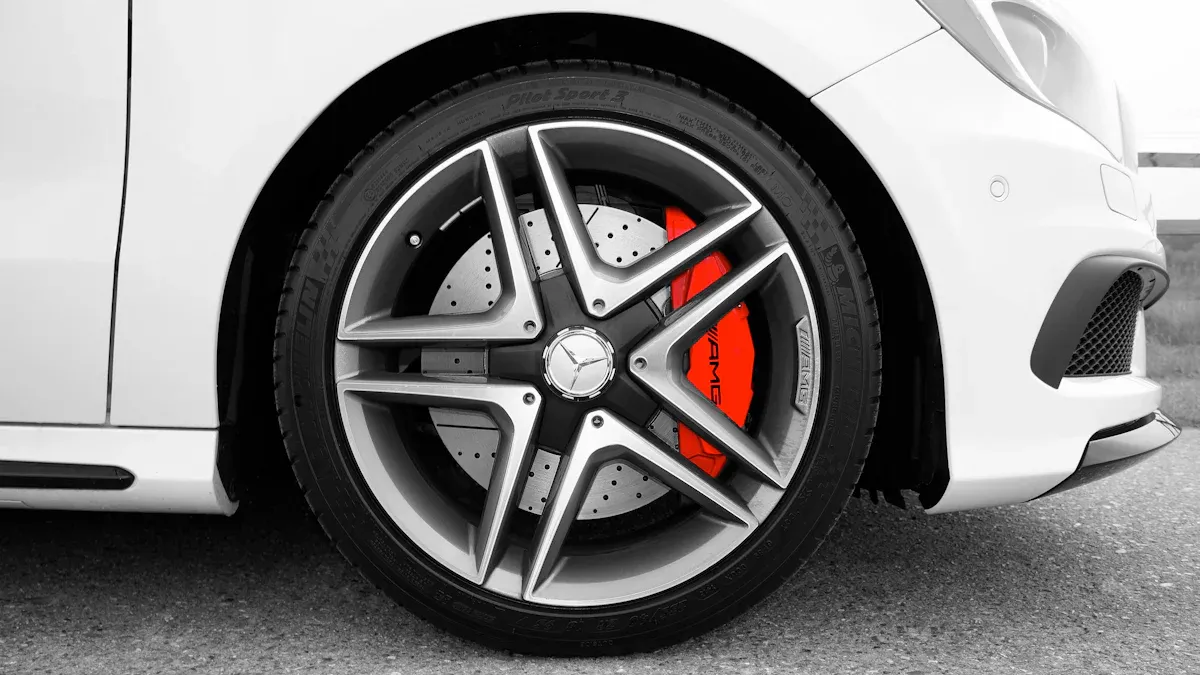Comparing the Thermal Behavior of Nitinol Tubing and Titanium Alloys

Industries like aerospace and medical devices need special materials that exhibit excellent Nitinol tubing thermal properties.
These materials must handle heat well to work properly.
Nitinol tubing and titanium alloys act differently with heat, showcasing distinct Nitinol tubing thermal properties.
Nitinol can change shape and stretch easily in different conditions, which is a result of its unique thermal properties.
This makes it great for making medical tools and devices.
Titanium alloys are strong, light, and stay stable in heat, making them ideal for applications where Nitinol tubing thermal properties are not required.
They are perfect for building airplanes and spacecraft.
For example, Ti-6Al-4V alloy reacts to temperature changes, highlighting the importance of understanding Nitinol tubing thermal properties.
Heat affects its tiny structure when it is being made.
Comparing Nitinol and titanium helps engineers pick the right material based on their thermal properties.
Key Takeaways
Nitinol tubing is special because it can return to its shape. It is also very flexible, making it great for medical tools needing precision.
Titanium alloys are strong, light, and resist heat. This makes them perfect for airplanes and spaceships where strength matters.
Knowing how heat moves through materials is important. Nitinol holds heat longer, which helps in medical tools. Titanium alloys move heat quickly, which is useful in other areas.
Picking the right material is important. Use Nitinol for bendable medical tools. Use titanium for strong engineering projects.
In the future, mixing Nitinol's flexibility with titanium's strength could create better materials for many uses.
Overview of Nitinol and Titanium Alloys
Nitinol: Properties and Applications
Nitinol is a mix of nickel and titanium metals. It has special features that make it useful in many fields. It usually contains 50 to 51% nickel, which gives it unique traits. One amazing feature is its shape memory. This means it can return to its original shape after bending when heated to certain temperatures. This happens in a set temperature range, often between −20°C and +110°C, depending on how it’s used.
Nitinol is also super flexible and strong. This makes it great for medical tools. For instance, nitinol guidewires help doctors perform precise surgeries with smaller cuts. This leads to quicker healing and better results for patients. It is also safe for the body and doesn’t rust, so it lasts a long time in implants. Because of this, nitinol is used in stents, braces, and surgical tools.
Outside of healthcare, nitinol is used in robots and airplanes. It can handle heating and cooling many times without breaking. This makes it perfect for parts like sensors and moving devices. Its special features and flexibility make nitinol important in advanced engineering.
Titanium Alloys: Properties and Applications
Titanium alloys are known for being strong, light, and rust-proof. Alloys like Ti-6Al-4V are used in most titanium medical devices. They weigh about 4.5 g/cm³, making them light but tough. Their strength can go over 1200 MPa, so they work well in tough conditions.
In medicine, titanium alloys are used for bone implants, dental tools, and heart devices. They are safe for the body and don’t rust, so they last a long time. Removing extra elements like oxygen and nitrogen makes them less likely to crack, keeping them safe for important uses.
Titanium alloys are also great for planes and cars. They don’t rust easily, even in high heat, so they stay strong. They also keep their shape and strength in extreme conditions, lowering the chance of breaking. This makes them perfect for airplane parts, spaceships, and fast cars.
Titanium alloys are popular because they work well in many places. Their light weight, strength, and heat resistance make them a favorite for engineers and designers everywhere.
Nitinol Tubing Thermal Properties

Thermal Conductivity of Nitinol Tubing
Nitinol tubing has special thermal conductivity because of its two phases. The austenite phase, at higher temperatures, has a conductivity of 0.18 W/cm°C. The martensite phase, at lower temperatures, has a lower value of 0.086 W/cm°C. This difference happens because the atoms are arranged differently in each phase.
Phase | Thermal Conductivity (W/cm°C) |
|---|---|
Austenite | 0.18 |
Martensite | 0.086 |
Nitinol's low thermal conductivity is useful for limiting heat transfer. This makes it great for medical devices, keeping them safe and steady during temperature changes.
Transition Temperatures and Shape Memory Effect
Nitinol tubing’s shape memory depends on its transition temperatures. These temperatures show when nitinol switches between martensite and austenite phases. Important temperatures include Ms (martensite start), Mf (martensite finish), As (austenite start), and Af (austenite finish). The hysteresis width, usually 20–50 °C, shows the range of this change.
Transition Temperature | Description |
|---|---|
Ms | Martensite start temperature |
Mf | Martensite finish temperature |
As | Austenite start temperature |
Af | Austenite finish temperature |
Hysteresis Width | Usually spans about 20–50 °C (36–90 °F) |
For example, at 81 °C, nitinol in the austenite phase acts elastic. At 18 °C, it stretches in the martensite phase due to detwinning. These features make nitinol tubing perfect for uses needing flexibility and thermal precision.
Heat Capacity and Thermal Stability of Nitinol
Nitinol tubing is very stable with heat. It can handle heating and cooling many times without breaking. Its heat capacity shows how much heat it needs to change temperature. This helps it work well in active environments.
With low thermal conductivity, clear transition temperatures, and strong stability, nitinol tubing is a top choice. It works well in healthcare and aerospace. Its ability to handle temperature changes while keeping its shape makes it reliable for important tasks.
Thermal Properties of Titanium Alloys
Thermal Conductivity of Titanium Alloys
Titanium alloys have special thermal conductivity, making them useful in engineering. Their conductivity ranges from 6 to 20 W/m·K. Several factors affect this:
Alloy Composition: Adding elements like aluminum changes heat transfer.
Temperature: Heat transfer improves as temperature increases.
Processing Methods: Casting or forging changes the material's structure.
Porosity: More pores lower the ability to transfer heat.
Surface Finish: Smoother surfaces help heat move better.
These features make titanium alloys great for aerospace and medical uses needing controlled heat transfer.
Heat Capacity and Thermal Stability of Titanium Alloys
Titanium alloys hold and handle heat very well. They stay strong even with changing temperatures. This is important in jet engines and spacecraft, where heat changes a lot. Their high melting point keeps them from breaking down. These qualities make them dependable for tough jobs needing precision and strength.
Resistance to Thermal Expansion in Titanium Alloys
Titanium alloys expand very little when heated. Their low expansion rate is about 8.6 x 10^-6 /°C. They also have high tensile strength, over 600 MPa, so they don’t bend under heat stress. This makes them perfect for parts like turbine blades and airplane structures that face repeated heating and cooling.
Comparing Nitinol Tubing Thermal Properties with Titanium Alloys

Differences in Thermal Conductivity
Nitinol tubing and titanium alloys transfer heat differently. Nitinol tubing has lower heat transfer ability. In its austenite phase, it transfers heat at 0.18 W/cm°C. In the martensite phase, this drops to 0.086 W/cm°C. These changes happen because of how its atoms are arranged.
Titanium alloys transfer heat better, with values between 6 and 20 W/m·K. Things like added aluminum improve heat transfer, while pores reduce it. Titanium alloys are better for jobs needing fast heat removal. Nitinol tubing works best where slow, controlled heat transfer is needed.
Transition Temperatures and Phase Behavior
Nitinol tubing changes between two phases: austenite and martensite. This switch happens at specific temperatures, like Ms (martensite start) and Af (austenite finish). The temperature range for this change is usually 20–50 °C (36–90 °F). This lets nitinol tubing return to its shape after bending, making it useful for flexible tools.
Titanium alloys don’t change phases like nitinol. Their structure stays steady even in high heat. This makes them reliable for tough jobs like building airplanes or medical devices.
Heat Capacity and Stability Comparisons
Nitinol tubing and titanium alloys handle heat differently. Nitinol tubing needs less energy to change its temperature. It also stays strong through many heating and cooling cycles, making it dependable in active settings.
Titanium alloys need more energy to heat up but stay very stable. They don’t break even in extreme heat changes. This makes them perfect for engines and spacecraft, where materials face a lot of heat stress.
Testing Methods for Thermal Properties
Differential Scanning Calorimetry (DSC) for Phase Transitions
Differential Scanning Calorimetry (DSC) helps study material phase changes. It measures heat flow as the material heats or cools. For Nitinol, DSC shows key temperatures like martensite start (Ms) and austenite finish (Af). These temperatures explain its shape memory ability.
One study used DSC to test Nitinol in actuators. The results showed how it bends and moves during phase changes. This proves Nitinol’s strength and flexibility after many heat cycles. DSC is very useful for studying materials like Nitinol.
Measuring Thermal Conductivity in Nitinol and Titanium Alloys
Thermal conductivity tests show how materials move heat. Nitinol transfers heat differently in its two phases. In the martensite phase, it transfers heat at 0.086 W/cm°C. In the austenite phase, it transfers heat at 0.18 W/cm°C. This happens because of its atomic structure.
Titanium alloys transfer heat better than Nitinol. Pure titanium transfers heat at 22 W/m·K at room temperature. At higher temperatures, it drops to 16–18 W/m·K. Titanium alloys like Ti-6Al-4V transfer heat between 7 and 12 W/m·K. These numbers show titanium alloys are great for managing heat.
Evaluating Heat Capacity and Thermal Expansion
Heat capacity tests show how much energy heats a material. Nitinol needs less energy to heat up, so it reacts quickly. It stays strong even after many heating and cooling cycles. This makes it perfect for medical tools and devices.
Titanium alloys need more energy to heat but handle heat stress well. They expand very little when heated, about 8.6 x 10^-6 /°C. This keeps them stable in high heat. These features make titanium alloys ideal for planes and engineering projects needing strength and stability.
Practical Implications of Thermal Behavior
Nitinol Tubing in Medical Devices
Nitinol tubing is very useful in medical tools. It works well with the human body, so implants are less likely to be rejected. It also doesn’t rust, making it great for long-term use inside the body. Its shape memory lets it adjust to body changes while staying strong. This helps patients heal better. Nitinol’s superelasticity means it can bend and return to its shape. This makes it perfect for small surgeries with less cutting.
Property | Benefit | Use in Medical Devices |
|---|---|---|
Biocompatibility | Works well with human tissue, lowering rejection risks. | Implants |
Corrosion Resistance | Doesn’t rust, lasting longer in the body. | Long-term implants |
Shape Memory | Adjusts to body changes while staying strong, helping patients. | Stents, catheters, flexible needles |
Superelasticity | Bends and returns to shape, great for small surgeries. | Minimally invasive procedures |
Nitinol can handle heating and cooling many times without breaking. It is used in stents, catheters, and surgical tools to improve healthcare.
Titanium Alloys in Aerospace Applications
Titanium alloys are important for airplanes and spacecraft. They are strong but light, which helps planes work better. They don’t rust, even in tough weather at high altitudes. These alloys can handle heat between 500–600 °C, so they are good for engines and other hot parts.
Property | Description |
|---|---|
High Strength | Very strong, good for parts under a lot of stress. |
Corrosion Resistance | Doesn’t rust, even in tough weather. |
Strength-to-Weight Ratio | Light but strong, improving how planes perform. |
Operating Temperature Range | Works well in heat up to 500–600 °C, great for engines. |
Machinability | Easy to shape and make into parts. |
Titanium alloys stay strong in extreme conditions, making them reliable for planes and cars. They are also easy to shape, which helps in building advanced machines.
Material Selection Based on Thermal Needs
Choosing materials depends on how they handle heat. Nitinol tubing is great for medical tools because it can bend and adjust while staying strong. It also works well in places with changing temperatures. Titanium alloys are better for planes because they are strong, light, and stable in heat. Their density is about 4.5 g/cm³, and they can handle stress up to 900 MPa.
Studies show that material properties like weight and strength matter a lot. For example, Ti-6Al-4V has a density of 4.43 g/cm³ and a strength-to-weight ratio of 203 MPa/gcm³. This makes it a top choice for planes and cars. Picking the right material based on heat and strength is very important.
The thermal properties of Nitinol tubing and titanium alloys are very different. Nitinol can change shape and stretch because of phase changes. Titanium alloys, however, transfer heat better and stay strong in tough conditions. These traits help decide their use in medical tools or airplanes.
Future Outlook: Mixing Nitinol's bending ability with titanium's strength could be useful. New tests like laser flash analysis might explain these materials better. Studying these ideas could bring exciting changes to many industries.
FAQ
What makes Nitinol tubing special compared to titanium alloys?
Nitinol tubing can remember its shape and is super flexible. It goes back to its original form after bending when heated. Titanium alloys don’t have this ability but are very strong. They resist heat and rust, making them great for airplanes and spacecraft.
Tip: Pick Nitinol for flexibility; choose titanium for strength and durability.
Why does thermal conductivity matter when choosing materials?
Thermal conductivity shows how well a material moves heat. Nitinol has low thermal conductivity, which is good for medical tools needing steady heat control. Titanium alloys transfer heat better, so they work well in engines or spacecraft that need quick heat removal.
How do Nitinol and titanium alloys react to temperature changes?
Nitinol changes between two phases, martensite and austenite. This lets it remember its shape. Titanium alloys stay steady even in extreme heat. They expand very little, making them reliable for tough jobs like building planes or cars.
Can Nitinol and titanium alloys be used together?
Yes, combining Nitinol’s flexibility with titanium’s strength can make better materials. These hybrids could improve medical tools or airplane parts by mixing adaptability with toughness.
Note: Scientists are still studying these combinations, which could change engineering.
Which industries use these materials the most?
The medical and aerospace industries use them a lot. Nitinol is perfect for stents, wires, and surgical tools because it’s flexible and safe for the body. Titanium alloys are key for planes, spaceships, and cars because they are strong, light, and resist heat.
Emoji Insight: ✈️ Planes and 🏥 hospitals depend on these amazing materials.
See Also
Evaluating Nitinol Tubing Strength Against Stainless Steel Options
The Manufacturing Process of Nitinol Tubing for Healthcare
Investigating Nitinol Tubing Uses in Medical Equipment

